
Stephan's Quintet is a visual grouping of five galaxies of which four form the first compact galaxy group ever discovered. The group, visible in the constellation Pegasus, was discovered by Édouard Stephan in 1877 at the Marseille Observatory. The group is the most studied of all the compact galaxy groups. The brightest member of the visual grouping is NGC 7320, which has extensive H II regions, identified as red blobs, where active star formation is occurring.

NGC 7320 is a spiral galaxy in the constellation Pegasus. It was discovered on 27 September 1873 by French astronomer Édouard Stephan.

NGC 5921 is a barred spiral galaxy located approximately 65 million light-years from the Solar System in the constellation Serpens Caput. It was discovered by William Herschel on 1 May 1786. In February 2001 a type II supernova was discovered in NGC 5921. It is a member of the Virgo III Groups, a series of galaxies and galaxy clusters strung out to the east of the Virgo Supercluster of galaxies.
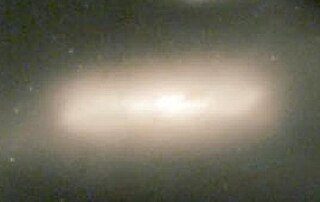
NGC 6027 is a lenticular galaxy which is the brightest member of Seyfert's Sextet, a compact group of galaxies. It was discovered by French astronomer Édouard Stephan on 20 March 1882.

NGC 6027a is a spiral galaxy that is part of Seyfert's Sextet, a compact group of galaxies, which is located in the constellation Serpens. In optical wavelengths, it has a strong resemblance to Messier 104, the Sombrero Galaxy, with which it shares a near equivalent orientation to observers on Earth.

NGC 6027b is an interacting lenticular galaxy that is part of Seyfert's Sextet, a compact group of galaxies currently in the process of colliding and merging, which is located in the constellation Serpens.

NGC 6027c is a barred spiral galaxy that is part of Seyfert's Sextet, a compact group of galaxies, which is located in the constellation Serpens.

NGC 6027d is a barred spiral galaxy that is strictly a visual member of Seyfert's Sextet, a compact group of galaxies, which is located in the constellation Serpens. NGC 6027d is not interacting with the other galaxies in the cluster, but is in the background and just happens to be in the same line of sight. The galaxy is nearly 700 million light years away from the interacting group and is believed to be extremely large in size.
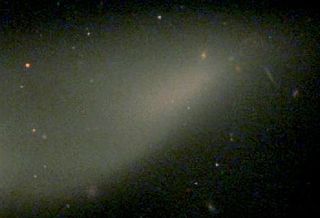
NGC 6027e is a tidal tail of NGC 6027, not an individual galaxy, that is part of Seyfert's Sextet, a compact group of galaxies, which is located in the constellation Serpens.
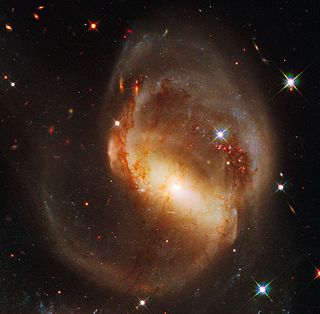
NGC 7319 is a highly distorted barred spiral galaxy that is a member of the compact Stephan's Quintet group located in the constellation Pegasus, some 311 megalight-years distant from the Milky Way. It was discovered on 27 September 1873 by French astronomer Édouard Stephan.

NGC 7331 Group is a visual grouping of galaxies in the constellation Pegasus. Spiral galaxy NGC 7331 is a foreground galaxy in the same field as the collection, which is also called the Deer Lick Group. It contains four other members, affectionately referred to as the "fleas": the lenticular or unbarred spirals NGC 7335 and NGC 7336, the barred spiral galaxy NGC 7337 and the elliptical galaxy NGC 7340. These galaxies lie at distances of approximately 332, 365, 348 and 294 million light years, respectively. Although adjacent on the sky, this collection is not a galaxy group, as NGC 7331 itself is not gravitationally associated with the far more distant "fleas"; indeed, even they are separated by far more than the normal distances of a galaxy group.
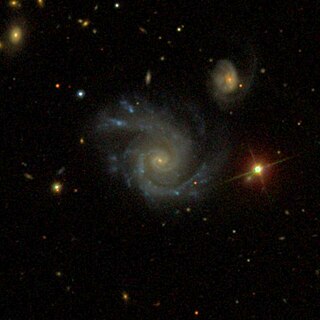
NGC 5829 is a spiral galaxy located in the constellation Boötes. It is 281 million light-years away from Earth and was discovered by astronomer, Edouard Stephan in May 1882.

NGC 218, also known as UGC 480, is a spiral galaxy located approximately 500 million light-years from the Sun in the constellation Andromeda. It was discovered on October 17, 1876 by Édouard Stephan, and is interacting with the galaxy PGC 2726.

LEDA 83677 is a lenticular galaxy located about 290 million light-years away in the constellation Coma Berenices. It is a member of the Coma cluster of galaxies. LEDA 83677 is also classified as a type 1 Seyfert galaxy. The core of the galaxy is emitting high-energy X-rays and ultraviolet light, probably caused by a massive black hole lurking in the core.
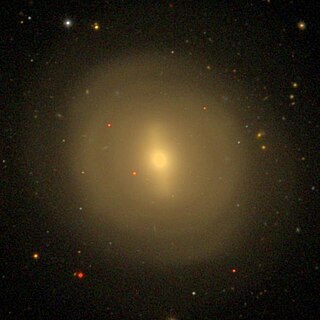
NGC 4477 is a barred lenticular galaxy located about 55 million light-years away in the constellation of Coma Berenices. NGC 4477 is classified as a type 2 Seyfert galaxy. The galaxy was discovered by astronomer William Herschel on April 8, 1784. NGC 4477 is a member of Markarian's Chain which forms part of the larger Virgo Cluster.

NGC 1019 is a barred spiral galaxy approximately 316 million light-years away from Earth in the constellation of Cetus. It was discovered by French astronomer Édouard Stephan on December 1, 1880 with the 31" reflecting telescope at the Marseille Observatory.

NGC 5508 is a very large and distant spiral galaxy located in the constellation Boötes. Its velocity relative to the cosmic microwave background is 11,615 ± 15 km/s, which corresponds to a Hubble's law of 171 ± 12 Mpc. It was discovered by French astronomer Édouard Stephan in 1882.

NGC 7466 is a spiral galaxy in the constellation of Pegasus. Its velocity with respect to the cosmic microwave background is 7160 ± 25 km/s, which corresponds to a Hubble distance of 105.60 ± 7.40 Mpc. It was discovered by French astronomer Édouard Stephan on 20 September 1873. It was independently rediscovered by the French astronomer Guillaume Bigourdan on 19 November 1895 and listed as IC 5281 in the Index Catalogue.
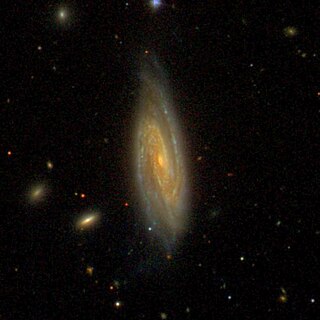
NGC 958 is a barred spiral galaxy in the constellation of Cetus. Its velocity with respect to the cosmic microwave background is 5505 ± 17 km/s, which corresponds to a Hubble distance of 81.20 ± 5.69 Mpc. However, 19 non-redshift measurements give a distance of 58.93 ± 12.91 Mpc. The galaxy was discovered by German-British astronomer William Herschel on 20 September 1784.

NGC 3052 is a intermediate spiral galaxy in the constellation of Hydra. Its velocity with respect to the cosmic microwave background is 4122 ± 24 km/s, which corresponds to a Hubble distance of 60.79 ± 4.27 Mpc. However, 19 non redshift measurements give a distance of 42.563 ± 6.434 Mpc. The galaxy was discovered by German-British astronomer William Herschel on 7 February 1785.



















